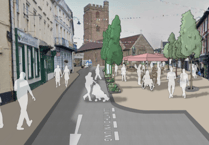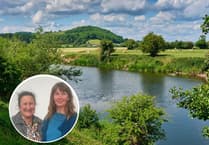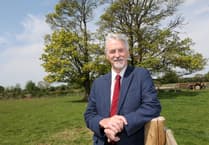The normally clear waters of River Wye turned green this week due to a proliferation of microscopic plants known as algae. Over the past three or four years the river’s previously mild algal blooms have become significantly more intense and prolonged. There are now serious concerns over the permanently damaging effects these severe blooms are having on the ecology of this highly protected river, along with the people and businesses that rely on it.
Discolouration of the water by algal blooms prevents essential sunlight reaching essential aquatic plants such as ranunculus, killing them off. These plants play a vital role in the river’s ecology, providing food and habitat for a range of invertebrate, fish and bird species. In addition, excessive algae reduces the availability of oxygen in the water at nighttime which, when combined with high temperatures, can kill fish such as Atlantic salmon, barbel and brown trout.
Algal blooms are caused by a combination of factors, including levels of light and flow. However, a large increase in the amount of phosphate, which acts as a fertilizer, entering the Wye is thought to be the principal reason for the recent increase in the blooms’ severity.
The geographical location of this extra phosphate is also believed to be a factor. The upper river in Wales is now a significant source following a large expansion of the poultry industry over the last decade. Since 2008 the catchment of one of the river’s tributaries in Powys now hosts an extra ten million chickens. This has produced massive amounts of highly reactive phosphates from their manures.
The proportion of phosphate in the Wye from agriculture has doubled in the past six years. The river is now failing its permitted levels of phosphate under the EU Habitats Directive.
Simon Evans, CEO of the Wye and Usk Foundation said: “The ecological deterioration of the Welsh Wye continues. Both Powys County Council and Natural Resources Wales have a legal responsibility to protect Special Areas of Conservation (SACs) like the Wye, but apparently have been unwilling to use the existing laws to protect the river from the nation’s desire to eat more free range eggs. In the case of Powys County Council, this includes considering the impact of new poultry developments individually and cumulatively. Evidently, this is something that is not happening.”
He added: “The result is a river, once voted the UK’s favourite, turning a putrid green every summer and having its ecology destroyed. Despite Welsh Government’s outward desire for sustainability and the protection of Future Generations, not to mention their legal obligations, there is little appetite to curb the planning excesses and environmental damage arising: this is a disgrace.”
Liz Price, the Wye & Usk Foundation’s Head of Landuse (Wales), said: “All the farmers I know in Powys want to operate in an environmentally responsible way. They have been let down by the council planners who they assumed would be processing their applications with the correct environmental assessments.”
Dr Stephen Marsh-Smith OBE, Executive Director of Afonydd Cymru, the umbrella organisation for Wales’s river trusts said: “The situation on the Wye mirrors the situation across much of Wales. There have been algal blooms in other Welsh rivers including the Usk, Tywi and Cleddau. Special Areas of Conservation are adversely affected by uncontrolled agricultural intensification, especially of the dairy industry in the south west. In 2018 Afonydd Cymru lodged a formal complaint to the European Commission about the lack of regulation in Wales, inappropriate planning and lack of Water Protection Zones”.
Adam Fisher, owner of Fishers, an angling and clothing store in Ross-on-Wye commented: “For the past three or four years the river has turned a sickly colour and appeared lifeless just as the tourist season starts. For the large number visitor-reliant businesses up and down the Wye Valley preparing to resume after the COVID-19 crisis, this is nothing short of a disaster.”
Maurice Hudson, a local salmon angler who has fished the Wye for over seventy years said: “In the last six years I have noticed a deterioration in the river’s health. The part of the river where I fish was always best in low water levels in the spring and summer. Now the river is thick with algae at these times meaning it is impossible to fish. You can’t even find small creatures in the shallows like bullhead anymore.”A spokesperson for Powys County Council said: “The council is fully aware of its statutory duty to conserve and enhance biodiversity, and this includes the many important habitats found in the county such as the River Wye Special Areas of Conservation. “Where planning applications, including those for intensive livestock units, have the potential to impact on the River Wye Special Areas of Conservation, they are assessed, under the habitats regulations, to evaluate their acceptability. “Natural Resources Wales, as the main environmental regulatory body for Wales, also carefully reviews such applications and in some instances also requires developers to obtain an Environmental Permit. “All planning applications are publicised by the Council and we welcome any comments or evidence on their potential impacts on the environment, or other matters, so that these can be fully considered as part of the application’s determination.”





Comments
This article has no comments yet. Be the first to leave a comment.